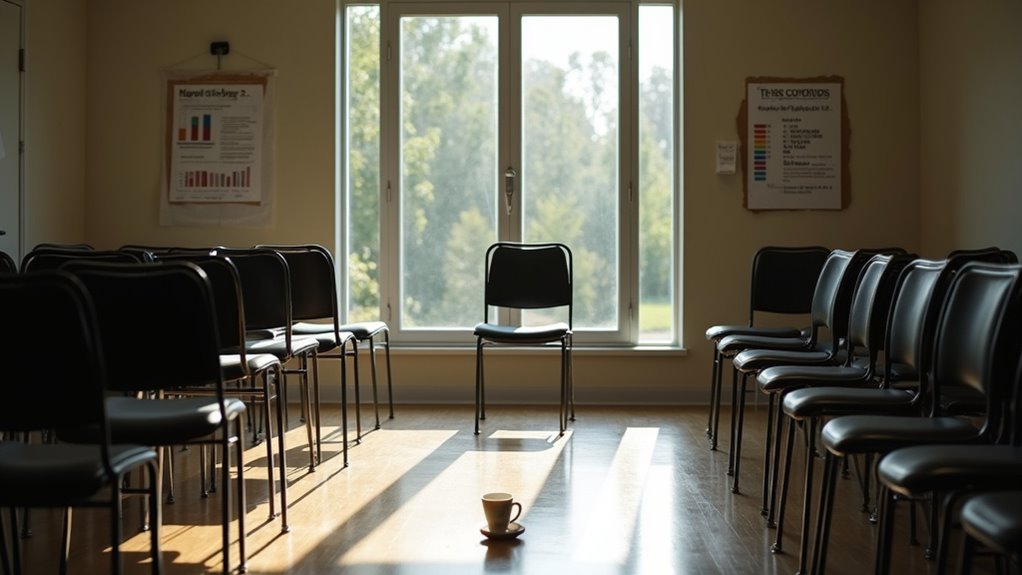Addiction treatment programs show significant effectiveness when you receive evidence-based care. Research indicates 75% of participants achieve recovery through integrated approaches combining medication with psychological interventions. You’ll experience the highest success rates (85-95%) by completing a full program that includes both medical and behavioral components. While initial relapse rates range from 40-60%, maintaining long-term treatment reduces this risk substantially. Understanding the specific factors that influence these outcomes can help enhance your chances of sustained recovery.
Understanding Addiction Treatment Success Metrics

How do we effectively measure success in addiction treatment? The key treatment metrics reveal varied outcomes across different programs and substances.
Core recovery benchmarks show 89% of alcohol rehab patients maintain sobriety at one month, with rates stabilizing to 70% by nine months post-treatment. Studies indicate that relapse rates typically range between 40-60% for substance use disorders. Inpatient programs demonstrate notably higher success rates compared to other treatment types. Engaging in treatment for longer durations of over three months significantly improves clinical outcomes and reduces relapse risk.
While most alcohol rehab patients achieve early sobriety, the real challenge emerges as success rates decline over subsequent months.
Program completion serves as a critical indicator, with 68% of patients achieving success when they finish their prescribed treatment course. However, the comprehensive completion rate stands at 43%, highlighting a significant gap.
Substance-specific data demonstrates higher success rates for alcohol and marijuana treatment (45% and 36% respectively) in outpatient settings. Medication-assisted treatment for opioid dependency shows 41% completion, though only 13% shift to outpatient care.
These metrics provide essential insights into treatment effectiveness and areas requiring intervention improvement.
The Reality of Recovery Program Outcomes

While addiction recovery outcomes vary greatly across treatment modalities and substances, thorough data reveals both promising success rates and persistent challenges. Understanding these outcomes helps you set realistic expectations for your recovery experience.
Key success metrics include:
- 42% of patients complete their initial treatment program, with 76% maintaining sobriety at three months.
- Medication-assisted therapy reduces overdose risk fivefold during active treatment phases.
- Extended care programs (12+ months) demonstrate superior relapse prevention outcomes.
Your recovery resilience considerably improves through evidence-based approaches combining behavioral therapy, medication protocols, and continuous support networks. Modern rehab programs emphasize quality of life improvements beyond just abstinence tracking. Approximately 75% of individuals who participate in treatment programs eventually achieve recovery, demonstrating the effectiveness of professional intervention. Florida treatment centers show the highest completion rates at 70%, setting benchmarks for program success nationwide.
Success rates vary by substance: alcohol (50-60%), opioids (30-50%), and methamphetamine (20-30%). These statistics underscore the importance of personalized treatment plans and ongoing engagement in aftercare programs to maintain long-term sobriety.
Exploring Different Treatment Approaches

Modern addiction treatment encompasses diverse, evidence-based approaches customized to address both physiological dependence and psychological components of substance use disorders.
Evidence-based addiction treatment addresses the whole person, combining medical intervention with psychological support to create lasting recovery solutions.
You’ll find that integrated approaches combine medication-assisted treatment (MAT) with behavioral interventions like CBT and motivational interviewing, creating a more thorough recovery framework. Treatment success rates show that evidence-based practices significantly improve recovery outcomes when properly implemented.
For opioid addiction, you’ll receive medications such as methadone or buprenorphine alongside counseling, while alcohol dependence treatment might involve naltrexone with CBT.
These holistic therapies address both physical cravings and underlying psychological triggers. Programs also incorporate specialized interventions for complex needs, including trauma-informed care and dual diagnosis treatment.
Support systems extend beyond clinical care through aftercare programs, regular monitoring, and community-based support groups, ensuring you maintain long-term recovery through multiple therapeutic channels.
Outpatient vs. Inpatient Treatment Effectiveness
Research demonstrates that both inpatient and outpatient programs can achieve comparable success rates when matched appropriately to your addiction severity and personal circumstances.
You’ll find that inpatient programs, typically lasting 30-90 days, offer intensive, structured environments with 24/7 supervision, while outpatient treatments provide flexible scheduling over several months with real-world integration opportunities. Both treatment types incorporate individual and group therapy as core components of recovery.
Studies have shown that longer treatment periods consistently improve recovery outcomes, regardless of whether you choose inpatient or outpatient care.
Your treatment success fundamentally depends on program alignment with your specific needs, including factors such as addiction severity, existing support systems, and co-occurring mental health conditions.
Many patients benefit from participating in support groups like AA as a complementary component to their primary treatment program.
Treatment Setting Success Rates
Treatment success rates between inpatient and outpatient addiction programs reveal nuanced effectiveness patterns dependent on patient-specific factors. The treatment environment markedly impacts outcomes, with data showing comparable efficacy for appropriately matched candidates. However, accessibility challenges often influence program selection beyond clinical considerations.
Key success rate determinants include:
- Severity level – Patients with severe addiction demonstrate higher success rates in inpatient settings due to 24/7 medical supervision and structured support.
- Support network strength – Outpatient programs show improved outcomes when patients have strong personal support systems. Insurance providers often prefer outpatient programs due to their lower costs while maintaining therapeutic effectiveness.
- Clinical stability – Those with co-occurring disorders typically achieve better results in inpatient settings offering thorough dual diagnosis care.
Like other chronic conditions, addiction treatment typically sees a 40-60% relapse rate, requiring ongoing evaluation and adjustment of therapeutic approaches. Research indicates that shifting from inpatient to outpatient care can optimize long-term recovery by combining intensive initial support with real-world coping skill development.
Program Duration and Outcomes
Compelling evidence from long-term studies demonstrates distinct outcome patterns between inpatient and outpatient addiction programs, with treatment duration markedly impacting recovery success.
You’ll find that longer treatment durations, particularly those extending beyond 12 months, greatly reduce your relapse and overdose risks. Outcomes analysis shows that while inpatient programs provide intensive, structured environments for early recovery, outpatient treatments excel in sustained support.
You’ll see varying success rates: outpatient alcohol rehab shows 89% sobriety at one month, declining to 70% by nine months. However, if you complete your program, you’re more likely to maintain abstinence, with 85-95% of completers remaining sober after nine months.
MAT participants specifically show five times lower overdose rates during treatment, though effectiveness requires consistent long-term engagement.
Care Level Impact Factors
When selecting between outpatient and inpatient addiction treatment, the severity of substance use disorder serves as a primary determinant of care level effectiveness. Clinical research demonstrates that care level outcomes correlate directly with addiction severity and the presence of co-occurring disorders.
Key factors influencing treatment success include:
- Patients with mild substance use disorders often achieve positive outcomes through outpatient programs, particularly when maintaining stable environments and strong support systems. Historical data shows that outpatient treatment has lower completion rates compared to residential programs. The flexibility to maintain daily responsibilities makes outpatient care an attractive option for many individuals.
- Severe addiction cases require inpatient care’s intensive medical supervision, especially during withdrawal phases and when managing complex psychiatric comorbidities.
- Treatment environment greatly impacts recovery, with inpatient facilities providing trigger-free settings and 24/7 clinical oversight, while outpatient programs allow real-world coping skill development.
Your success depends on matching care level intensity to your specific clinical needs and circumstances.
Medication-Assisted Treatment Performance Data
Recent evidence demonstrates the substantial clinical efficacy of Medication-Assisted Treatment (MAT) across multiple performance metrics.
You’ll find medication effectiveness data showing that methadone patients exhibit 33% fewer opioid-positive tests and are 4.44 times more likely to remain in treatment compared to controls. MOUD reduces overdose risk by 76% at three months and 59% at one year. Nonintensive behavioral health treatment shows promise in reducing serious opioid-related acute care visits.
Treatment adherence data reveals a clear correlation between duration and outcomes. When you maintain MOUD beyond 180 days, overdose rates drop from 6.4% to 1.1%, while serious acute care utilization decreases from 8.2% to 2.6%. This chronic brain disease requires continuous management, similar to other long-term medical conditions.
Staying in MOUD treatment past 180 days dramatically reduces both overdose risk and the need for emergency medical care.
Despite these compelling results, only 25.1% of OUD patients received medications in 2022, highlighting a significant treatment gap that requires addressing through improved access and retention strategies.
Key Factors Affecting Recovery Success
Treatment success rates vary considerably based on the substance type you’re addressing, with outpatient programs showing 45% success for alcohol and 36% for marijuana cases.
You’ll find that evidence-based approaches, including cognitive behavioral therapy and contingency management, demonstrate improved efficacy when matched to specific substance use disorders. Maintaining strong support systems plays a crucial role in achieving lasting recovery outcomes. According to national data, 20.5 million Americans struggle with substance use disorders annually.
Your recovery trajectory can be optimized through personalized treatment selection, as demonstrated by the 68% success rate among those who complete medically-supervised detoxification protocols.
Treatment Type Success Rates
Success rates in addiction recovery programs hinge on multiple interdependent factors, with program duration and intensity serving as primary determinants.
Treatment modalities comparison reveals considerable variations in efficacy, while success metrics evaluation demonstrates higher recovery rates in extensive care models.
Your chances of successful recovery increase with:
- Inpatient programs showing 30-50% higher success rates compared to outpatient care, particularly for severe substance dependencies.
- Medication-assisted treatment (MAT) reducing relapse risk by up to 50% when combined with behavioral therapies.
- Dual diagnosis programs achieving 42% completion rates when incorporating integrated mental health treatment.
You’ll find that longer treatment durations (12+ months) consistently correlate with improved outcomes, while structured aftercare and community support systems greatly reduce relapse risk.
MAT protocols, particularly for opioid addiction, demonstrate superior efficacy when combined with extensive therapeutic approaches.
Substance-Specific Program Outcomes
Different substances of abuse present unique challenges in addiction recovery, requiring customized therapeutic approaches and specialized intervention strategies.
You’ll find that substance-specific strategies greatly impact program effectiveness across diverse drug categories.
For opioid addiction, medication-assisted treatment (MAT) demonstrates superior outcomes compared to behavioral therapy alone, while prescription opioid recovery requires careful tapering protocols. With 9.5 million adults suffering from both substance abuse disorders and mental illness, integrated treatment approaches are essential.
When you’re dealing with stimulant addiction, you’ll need extended treatment durations to address prolonged cognitive impairment.
Alcohol treatment programs must account for poly-drug use complications.
Your recovery success rates improve with targeted interventions: substance-specific relapse prevention plans, specialized withdrawal management protocols, and medication adjustments based on your specific substance use disorder.
Treatment programs incorporating these customized approaches show measurably better outcomes than generic recovery models.
Breaking Down Treatment Program Statistics
While addiction recovery outcomes vary considerably across programs and populations, extensive data analysis reveals distinct patterns in treatment efficacy.
Treatment demographics show that only 43% of patients complete their programs, with 16% transferring to alternative facilities. Recovery challenges mirror those seen in other chronic conditions, with relapse rates of 40-60% within the initial year.
Key statistical insights from clinical data:
- Post-discharge sobriety rates decline from 89% at one month to approximately 70% by nine months
- Long-term recovery rates reach 75%, according to CDC data, particularly when combining medication with psychological interventions
- Medication-assisted treatment (MAT) demonstrates 41% completion rates, with 13% successfully moving to outpatient care
This evidence supports the efficacy of thorough treatment approaches while highlighting the need for sustained support systems.
Measuring Long-Term Recovery Outcomes
Long-term recovery outcomes demonstrate complex trajectories across multiple dimensions, with remission rates showing considerable variability over extended timeframes.
You’ll find that initial remission rates of 71% at one year decline to 65% by years 5-7, though they slightly rebound to 67% at nine years, indicating fluctuating patterns of recovery sustainability.
The path to long-term abstinence typically requires multiple attempts, with 71% of individuals reporting previous month-long periods of sobriety before achieving stable recovery. Studies show that relapse rates reach 40-60% among those in recovery programs.
Service needs considerably decrease over time, from 87% requiring support at year one to 45% by year five.
Your success in maintaining recovery correlates strongly with treatment duration, social support networks, and consistent engagement in therapeutic interventions, particularly when combined with 12-Step program participation.
Evidence-Based Treatment Results Analysis
Recent analyses of evidence-based treatment outcomes reveal significant disparities between clinical trial efficacy and real-world effectiveness.
Treatment variability across facilities impacts evidence reliability, with only 51% of centers maintaining accreditation and even fewer implementing consistent evidence-based protocols.
Clinical data demonstrates:
- Medication-assisted treatments show superior outcomes, with buprenorphine achieving 75% success rates compared to placebo controls.
- Long-term recovery correlates strongly with treatment durations exceeding 90 days, though less than 43% complete their programs.
- Combined pharmacological and psychological interventions yield better results than single-modality approaches, yet most facilities don’t standardize this integration.
You’ll find substantial gaps between controlled study results and real-world implementation, highlighting the need for standardized protocols and quality metrics focused on patient outcomes rather than process measures.
Frequently Asked Questions
How Much Does Addiction Treatment Typically Cost With and Without Insurance?
Without insurance, you’ll face treatment costs ranging from $6,000-$20,000 monthly for inpatient care, while outpatient programs run $5,000-$15,000 for three months.
With insurance coverage, you’ll typically pay 10%-40% of these costs for in-network providers, plus copays of $20-$50 per session.
Your out-of-pocket maximum will usually be $4,000-$8,000 annually.
Medication-assisted treatment and community-based options can offer more affordable alternatives.
What Role Do Family Members Play in Successful Addiction Treatment?
Family involvement greatly increases treatment success rates through multiple evidence-based mechanisms. Your support system’s active participation boosts treatment adherence, reduces relapse risks, and improves long-term outcomes.
Effective communication strategies between family members and patients strengthen recovery dynamics by addressing codependency patterns and establishing healthy boundaries. Research shows that structured family therapy sessions, combined with educational components about addiction, create a more sustainable recovery environment and improve treatment completion rates.
Can I Keep My Job While Attending an Addiction Treatment Program?
Yes, you can maintain employment while seeking treatment.
Modern addiction programs offer treatment flexibility to support your work-life balance, with many facilities providing evening sessions and outpatient options.
Statistics show 70% of adults with SUDs remain employed, and workplace-supported recovery programs actually improve attendance by 23-64%.
Many employers now prioritize SUD treatment support, and integrated care models allow you to schedule treatment around work commitments.
How Long Should I Wait Before Dating Someone After Completing Addiction Treatment?
You should wait at least one year after completing addiction treatment before pursuing dating relationships.
This timeline allows you to establish emotional stability and focus on your recovery path. Your dating readiness depends on several clinical factors, including your progress in therapy, trigger management, and support system development.
Early dating can jeopardize your sobriety by introducing relationship stressors before you’ve fully developed healthy coping mechanisms and self-identity in recovery.
What Happens if I Relapse During or Immediately After Treatment?
If you relapse during or after treatment, remember it’s a common part of recovery – not a failure.
Immediately contact your treatment provider to assess relapse triggers and adjust your recovery strategies.
You’ll need to evaluate environmental factors, stress levels, and potential medication adjustments.
Your care team may intensify support through supplementary counseling, group therapy, or modified treatment approaches.
The key is to quickly re-engage with treatment rather than letting guilt prevent you from seeking help.






